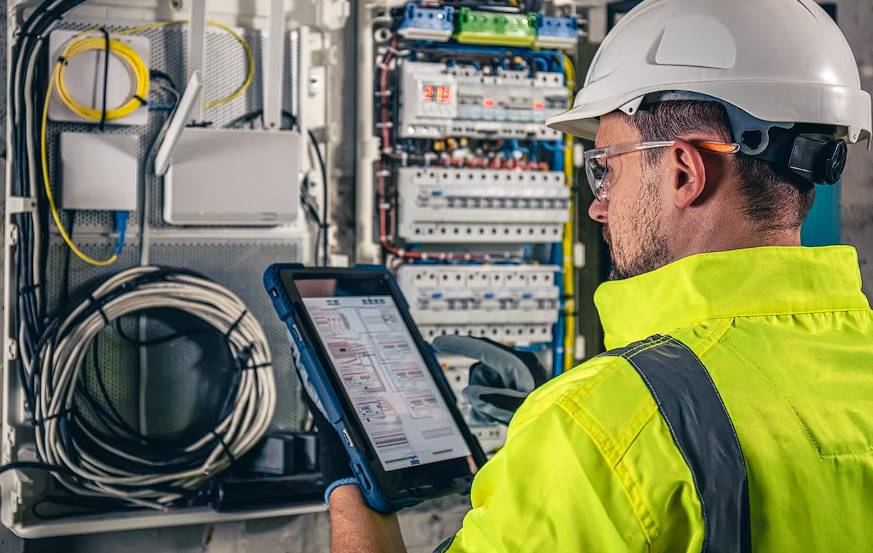To guarantee constant connectivity, modern enterprises must do regular network maintenance. A company's output can be boosted by facilitating effortless communication between applications and workers. Managers need to develop a systematic strategy for monitoring their networks.
If the company has a schedule for updating or maintaining its infrastructure, it may be confident that any technical issues will be fixed. Threats, outages, and faulty settings are all possible causes. Having a third-party IT company take care of your network's upkeep and upgrades is the best option.
Why Is the Maintenance and Upgrade of a Network So Important?
These days, the internet and online resources are indispensable to many enterprises. The use of these digital resources has increased our productivity as a team. However, maintaining such cutting-edge software requires regular network checks and updates. Some of the most crucial causes for this are:
Identifies Issues and Offers Solutions
Businesses can learn what's causing their network issues if they perform regular checks. Once the root causes have been identified, a solution can be implemented to restore normal network operation. Companies can always update their network if maintenance does not resolve the issue.
If they were to purchase and use cutting-edge technology, issues like network outages would be a thing of the past. By increasing their technological capability through upgrades, they can boost their output. Your company can benefit from seeking advice from an IT service provider in deciding which upgrades are necessary.
Defends you against Online Threats
The rate of cybercrime is skyrocketing, and if your network infrastructure isn't regularly updated, criminals will find a way to exploit it. Cybercriminals exploit your network's vulnerabilities using sophisticated techniques, including domain phishing and lateral movement. If they can break into your system using these methods, it might be disastrous for your finances and your reputation.
However, with regular monitoring and updates, businesses can better identify weak spots. The potential for unauthorised users to take advantage of these flaws can then be evaluated. Using the results of this study, necessary parts of a network system can be updated or repaired.
Contributes to Greater Efficiency
Companies and employees must increase their output more than ever to keep up with the market. Their success and productivity in the modern business world hinge heavily on the reliability of the underlying network infrastructure. Connection failures and outages are common results of using outdated network hardware.
These blunders can seriously slow down production. Therefore, it's important to prevent them at all costs. As a result, businesses everywhere should do routine maintenance and upgrades on their systems' networks. Using this information, they can determine the root causes of problems like downtime.
Helps Companies Expand
A company's reliance on the internet grows with its size today. To meet this demand, the organisation must maintain cutting-edge technology infrastructure. When trying to grow, it cannot be easy to justify spending much money on cutting-edge technology all at once.
Also, it's not always easy to anticipate exactly what will be needed. Therefore, it's only sometimes possible to make purchases in advance. Managers can learn the limitations of the current setup by routinely inspecting the equipment. After this is done, they can think about and purchase the required equipment to avoid a whole rebuild.
Consistently Meets Requirements of Regulations
The laws governing internet use, consumer information, and internet-access devices constantly evolve. To violate these compliance rules, it sometimes takes an out-of-date system. Dealing with such a situation can lead to hefty fines and a damaged reputation.
A company's ability to follow these laws and regulations is aided by the frequent maintenance and updating of its systems. Before beginning, businesses might compile a list of all the relevant laws and compliance procedures required by law. The company's current infrastructure can be tested against the requirements with the help of this checklist.
Helps Cloud Migration
Globally, businesses are increasingly depending on cloud-based software for increased efficiency. Companies should take baby steps when making the change to the cloud. This method essentially aids in deciding which assets should be moved to the cloud initially.
Keeping up with routine network maintenance can help a business prioritise its resources. With this data, they can determine which assets are most pressing to move into the cloud. This will enable the company to guarantee a smooth, uninterrupted transfer to the cloud.
Improves IT Visibility
Today, more than ever, it is crucial for businesses to be able to monitor their IT infrastructure. Companies may reduce downtime and improve threat management by increasing visibility into their IT infrastructure and learning how much bandwidth they use. All of these promote worker performance and productivity.
However, to provide such visibility, a business must thoroughly comprehend its IT topology. Team members can benefit from learning the ins and outs of the hardware and software architecture through routine maintenance checks. They can then utilise their familiarity with the system to check that every critical IT component is present.
Follow a brief checklist to keep your server infrastructure running smoothly.
HDD Checks
After repeated data rewrites, hard drives can fail. For better and longer HDD performance, running diagnostic tools that defragment the drives and sort the data stores can be helpful.
Server Backup Checks
Even if your cloud or offsite data backup is set to run automatically, it's still a good idea to verify its efficacy and timeliness regularly.
Operating Systems Verifications
The operating system (OS) is crucial to every computer system or network. Nothing would function without a reliable operating system, so it's essential always to have the most recent updates, including bug fixes.
Hardware Tests
Extended server use generates a lot of heat, which might damage numerous elements. Keep up with regular physical cleanings once a year to get rid of dust, debris, and anything else that may be causing problems with the system. Hardware compatibility diagnostics are also helpful for determining whether components and gadgets are beyond their prime. Therefore, it might need to be replaced.
Power Supply Scans
There should be regular inspections of the uninterruptible power supply (UPS) systems installed on servers. Their steady-state capability may decline over time. Because of this, the machines have to work harder to keep up with the workload.
Network Security Diagnostics
Begin an in-depth audit of your network's safety. As part of this process, you should use specialised tools to verify that only authorised users have access.
Security Software Updates
Firewalls are only useful for observing incoming traffic, and using an anti-virus program several versions out of date is harmful. These two are essential components of the upgraded software that provides security for servers and networks.
Reasons why networks may go down or have interruptions
The consequences of network outages due to technical difficulties are serious for any firm. Understand these typical network failure and disruption causes to reduce your business's financial and reputational harm.
Human Error
Human mistake is a potential root cause of network downtime. Users might easily cause problems by removing the wrong plug or failing to follow instructions. Network outages can also be caused by other factors, such as improperly configured devices, broken cables, or misplaced or broken hardware. Documentation, training of personnel, and equipment labels can help prevent these mistakes.
Power Failure
Large-scale lightning storms, tornadoes, fires, and floods can all lead to structural damage and power outages in your structure. Large amounts of data may be lost in such an incident, with little hope of restoration.
Ensure you have backup power sources in case of a power outage that could severely impact your operations. In the event of a power failure on a single circuit, you can prevent a complete service shutdown by connecting any redundant equipment to a different circuit.
Misconfiguration
Misconfiguration is a common source of unscheduled downtime. The good news is that you can lessen the likelihood of blunders. Instead of relying on manual ways to configure settings, you should use automation to roll out adjustments. Before implementing changes on live devices, ensure you've thoroughly tested every setting.
Hardware Failure
When hardware fails, it can cause disruptions in the network. When components of your company's information technology system stop functioning as intended, this is known as hardware failure. Water damage, a lack of maintenance, and voltage spikes are all problems that can cause hardware to fail. Your company could suffer irreparable harm if you fail to prepare for the possibility of hardware breakdowns.
Keeping your company's hardware up-to-date and secure from hardware failure is as simple as applying patches and routine maintenance. Incorporating redundancy that prevents disruption of the entire network due to a single point of failure is another way to lessen the impact of hardware problems.
Outdated Equipment
It can be challenging to balance investing in cutting-edge innovation and maintaining a minimal IT footprint. Businesses sometimes put off upgrading their technology because of the high price tag, yet every old computer or other device on the network is a security risk. Replacing ageing hardware and preparing for updates is important to prevent network downtime.
Cyberattacks and other breaches in security
A breach or cyber attack could be the result of a security flaw. When malicious users overwhelm a network, it can crash. Implementing suitable security controls can prevent hackers from bringing down your network and causing a security breach or cyber assault.
Methods for Preventing Internet Outages
By automating routine tasks and keeping meticulous records, your company can mitigate many of the causes of network failure symptoms. Further measures to avoid network problems include:
Switch to Cloud Services
Avoiding data loss during an outage makes the move to cloud services all the more important. Important company records shouldn't be kept primarily in the office. Consider switching to a cloud server instead, which offers increased security, portability, and dependability. Smartphones can access cloud data.
Establish a Backup Data Connection
Having a backup network connection is another choice for minimising network outages. Many firms can only function for a few hours with regular internet access. However, some may be able to keep going for longer. In this situation, having a backup network connection is crucial. If one network experiences issues, a redundant connection can take over and continue serving users.
Spend Money on Reliable Networks
Choosing cheaper hardware may seem like a good way to save money, but it increases the risk to your business. When weighed against the potential losses to your business, the cost reductions are insignificant. The productivity loss caused by a slow connection can be avoided using higher-grade technology, which is also more reliable.
Check for Security Flaws and Weaknesses in Your System
When an outage or downtime occurs at your company, the first step is to pinpoint its cause. For instance, if the electricity in your workplace suddenly goes out, you'll need to figure out if the problem is localised to a single fuse box or affects the entire grid. System downtime can be avoided if precautions are taken against both internal and external threats.
Conclusion
Regular network maintenance and upgrades are crucial for modern enterprises to ensure constant connectivity and boost productivity. By developing a systematic strategy for monitoring networks, businesses can identify and address network issues, preventing threats, outages, and faulty settings. Regular maintenance also helps protect against online threats, as cybercriminals exploit vulnerabilities using sophisticated techniques. By identifying weak spots and evaluating potential vulnerabilities, businesses can update or repair necessary parts of their network systems.
Maintaining a reliable network infrastructure also contributes to greater efficiency, as connection failures and outages can slow down production. Regular maintenance helps companies expand by identifying the limitations of their current setup and making necessary purchases in advance. Consistently meeting regulatory requirements is also essential, as outdated systems can lead to fines and damaged reputations.
Cloud migration is becoming increasingly important, and businesses should prioritize their resources by ensuring a smooth, uninterrupted transfer to the cloud. By regularly maintaining and updating their network infrastructure, businesses can ensure they are meeting the evolving laws and regulations governing internet use, consumer information, and internet-access devices.
Monitoring IT infrastructure is crucial for businesses to reduce downtime and improve threat management. To achieve this, it is essential to understand the hardware and software architecture, perform routine maintenance checks, and ensure that all critical components are present.
To keep server infrastructure running smoothly, follow a checklist of checks such as HDD checks, server backup checks, operating system verifications, hardware tests, power supply scans, network security diagnostics, and security software updates.
Network outages can be caused by human errors, power failures, misconfiguration, hardware failure, outdated equipment, and cyberattacks. Understanding these causes can help reduce financial and reputational harm for businesses.
Human error can cause network downtime, while power failures can lead to structural damage and data loss. Regular physical cleanings and power supply scans can help prevent these issues. Misconfiguration can also lead to unscheduled downtime, but automation can help reduce the likelihood of mistakes. Hardware failures can cause disruptions in the network, and keeping hardware up-to-date and secure is crucial.
Outdated equipment can be a security risk, and replacing ageing hardware and preparing for updates is essential to prevent network downtime. Cyberattacks can result from security flaws, so implementing suitable security controls can prevent hackers from causing network crashes.
To prevent internet outages, automate routine tasks and keep meticulous records. Consider switching to cloud services, establishing a backup data connection, and spending money on reliable networks. Check for security flaws and weaknesses in your system when an outage or downtime occurs, and take precautions against both internal and external threats to ensure a smooth operation.
Content Summary
- Regular network maintenance and upgrades are essential for ensuring constant connectivity in modern enterprises.
- Facilitating effortless communication between applications and workers boosts company output.
- Developing a systematic strategy for network monitoring is crucial for managers.
- Scheduled infrastructure maintenance instills confidence in resolving technical issues promptly.
- Network maintenance helps identify and address root causes of issues.
- Third-party IT companies are the best choice for network upkeep and upgrades.
- The internet and online resources are indispensable for many enterprises today.
- Maintaining cutting-edge software requires regular network checks and updates.
- Identifying network issues is a crucial outcome of regular checks.
- Upgrades can increase a company's technological capability and productivity.
- Cybercrime is on the rise, making network security updates vital.
- Regular monitoring and updates help identify and fix network vulnerabilities.
- Preventing connection failures and outages is essential for business efficiency.
- Routine maintenance and upgrades are necessary to prevent downtime.
- Growing companies need up-to-date technology infrastructure.
- Routine inspections help companies understand their equipment limitations.
- Compliance with evolving internet and consumer protection laws is aided by maintenance.
- Frequent updates ensure adherence to legal requirements.
- Network maintenance aids in prioritizing assets for cloud migration.
- Baby steps in moving to the cloud require data from routine network maintenance.
- Increased IT visibility leads to reduced downtime and improved threat management.
- Routine checks help employees understand hardware and software architecture.
- Server infrastructure requires regular maintenance for smooth operation.
- Hard drive checks and defragmentation improve HDD performance.
- Regular verification of server backups ensures data security.
- Keeping operating systems updated is crucial for system reliability.
- Regular physical cleaning and hardware tests prevent heat-related damage.
- Uninterruptible power supply systems should be inspected regularly.
- Specialized tools should be used to verify network security.
- Regular security software updates are essential for network protection.
- Network outages due to technical difficulties have serious consequences.
- Human error can lead to network downtime.
- Power failures from natural disasters can cause data loss.
- Backup power sources are crucial for preventing service interruptions.
- Misconfiguration is a common cause of unscheduled downtime.
- Automation and thorough testing help prevent misconfiguration errors.
- Hardware failure can disrupt network operations.
- Regular maintenance and redundancy reduce the impact of hardware failures.
- Outdated equipment poses security risks and should be replaced.
- Cyberattacks can lead to network crashes and security breaches.
- Implementing suitable security controls prevents network disruptions.
- Automation and meticulous record-keeping mitigate network failure causes.
- Switching to cloud services enhances data security and accessibility.
- Establishing a backup data connection is crucial for minimizing outages.
- Investing in reliable networks is essential for business productivity.
- Higher-grade technology helps avoid productivity loss due to slow connections.
- Regular checks help identify security flaws and weaknesses.
- Pinpointing the cause of outages is the first step in preventing downtime.
- Precautions against internal and external threats are essential for system reliability.
- Maintaining a secure network is crucial for business continuity and reputation.
Frequently Asked Questions
Upgrades can include faster hardware, increased bandwidth, and improved software, improving network speed and reliability.
Outdated equipment can be more susceptible to failures and security breaches, hindering overall network performance.
They can ensure your network scales with your business, preventing bottlenecks and performance issues.
Comprehensive documentation helps in tracking changes, troubleshooting, and planning upgrades effectively.
When planning an upgrade, consider your current needs, future growth, and budget, and seek expert advice to ensure a successful transition to a more robust network infrastructure.


